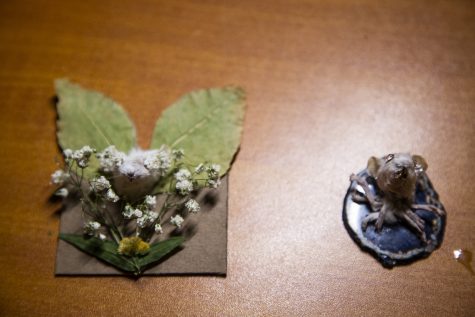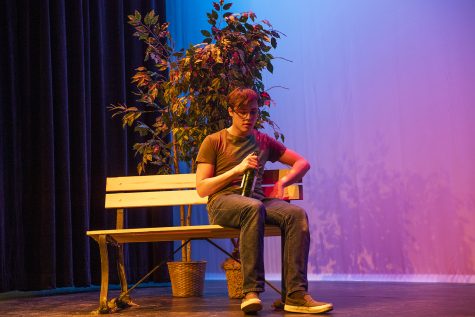The Art of Taxidermy, from a UI student’s apartment to a professional workshop
Taxidermy has remained a popular activity in hunting culture. A few local taxidermists give their take on their own personal craft.
January 23, 2019
A small white mouse gazes up with its beady, black eye, sporting a brightly colored outfit. It grasps a piece of fruit in its tiny paw, almost becoming too human.
At first glance, one would never know the mouse is already dead, stuffed with foam and stitched up. Its short life span extended, a transformation into a piece of art lasting through time.
University of Iowa sophomore Janiece Maddox has been interested in taxidermy since she was in high school. Starting in the pre-med track, Maddox was fascinated by anatomy and dissection, which were frequently brought up in her classes.
Maddox broke into taxidermy a year ago, primarily specializing in mice as her models.
Easing into her new hobby, she first buys dead mice from PetSmart from its freezer area, where they’re kept as food for reptiles. She previously made her creations in her dorm room, taking around 20 minutes for the dissection.
Before starting her project, she washes the body with cold water, then begins cutting the mouse from its spine. She dissects the creature until reaching its joints. At this point, she’ll dig her nails into the tail and fold it outwards.

UI sophomore Janiece Maddox works on a mouse at her apartment on Tuesday, January 22, 2019. Maddox started her taxidermy practice around a year ago.
Switching to another knife, Maddox then goes over the eyelids and ears. With a pair of scissors, she cuts through the skull, preserving the teeth.
After she washes the freshly cut pelt, Maddox will use the insides as a reference as she cuts the Styrofoam used to stuff the animal.
Crafting her ideal mouse, Maddox said, she finds the process to comparative with other art forms.
“It’s just as much of a sculpture as anything else is a sculpture,” Maddox said. “Take away the fact of what it was before — those are just raw materials that you have to work with, just like a block of clay. I think transformation is what makes it art.”
Taxidermy has a lengthy history found in many cultures. According to the Museum of Idaho’s “A brief, gross history of taxidermy,” the term was coined in 1803 by Louis Dufresne of the Muséum national d’Histoire naturelle in Paris. However, the ancient Egyptians, who preserved the pharaohs’ pets with injections, spices, and oils, used the practice much earlier.
Once the skin dries off, Maddox puts wires and cotton inside various parts of the body, allowing the mouse corpse to stand up. The foam is placed inside the head and she wraps the skinned pelt around, sewing it.
Maddox finally throws away the organs outside, leaving it as food for hungry animals.
I think, especially in American culture, there’s a taboo around death that once it’s dead, it’s disvalued.
— Janiece Maddox
Recently, she completed a project in which she dressed up mice imitating covers of Fools Magazine, posing them in an anthropomorphic manner. While many of her peers have felt taken aback by her hobby during her first year of college, Maddox said, people should be more open-minded about taxidermy, instead of feeling there’s a stigma about the deceased.
“I think, especially in American culture, there’s a taboo around death that once it’s dead, it’s disvalued,” Maddox said. “We just don’t respect dead things.”
Although taxidermy has received criticism from animal-rights groups, such as PETA, Maddox said she performs taxidermy because of admiration for animals.
“People think it’s [disrespectful] to [use] taxidermy [on] animals, but I think it shows respect in that it can transcend into something else,” she said.
While Maddox intends to leave taxidermy as a hobby, professional taxidermists in the Iowa City area continually work with clients to mount a wide variety of animals for a living.
Joe Meder, a professional taxidermist located in Solon, took a course at a natural-history museum, where he learned about taxidermy during school, sparking his passion for the subject at age 17.
After doing it many years, Meder wanted to take up the challenge of starting his own business.
According to Data USA, there are 513,071 taxidermists in the workforce, a profession that earns an average annual salary of $70,610.
Zebra pelts decorate the floors of Meder’s home, with two deers connected by their antlers rotating on a platform at the press of a button. Mounted buffalo heads seemingly gaze back at the room, and a cheetah is proudly placed above the fireplace.

Mouse heads, created by UI student Janiece Maddox, are seen at her apartment on Tuesday, January 22, 2019. Maddox started her taxidermy practice around a year ago.
Meder primarily specializes in larger animals, ranging from local woodland creatures to African wildlife. Pointing to a large mounted deer he sculpted himself near his lounge, Meder said he typically works with white-tailed deers.
Dan Fiala, another professional taxidermist in Solon, grew up in an environment in which he regularly hunted and fished, naturally taking an interest in taxidermy. He began taxidermy when he was a teenager during the ’80s.
As he grew more skilled in taxidermy, he struggled with balancing his full-time job with all of his taxidermy requests. Once he settled down with his family, Fiala started Timberline Taxidermy.
Fish and birds hang around his shop, along with a bobcat in progress placed in the middle. Like Meder, Fiala often works with deer.
When a client comes in with a deer, he will typically discuss what the person wants for a mount and the type of attitude it will project.
Fiala will scrape out the deer head, removing the skin. He’ll proceed to make measurements for the foam that will go inside the animal.
The animal then undergoes tanning, which transforms the skin into a stabalized state and helps preserves it. The process can take up to several months.
Onced it’s tanned, he’ll take the foam and place the skin around it. He’ll set the deer’s eye depending on the attitude, whether it’s aggressive, relaxed, or alert.
He then finishes the details, perfecting the nose, eyes, and mouth, making sure everything is anatomically correct.
“That’s when the animal comes back to life,” Fiala said.
He particularly enjoys working with larger, life-size animals, feeling that he has more opportunities for creative expression.
“With any mammal, especially one that’s life-size, you can really build in the artistic flair,” Fiala said. “Especially if you’re incorporating two life-size animals into one habitat base, you can give it action.”
Several of his clients will bring Fiala animals to mount because of the history behind them, whether it was the first deer a young boy shot or the first deer harvested on specific land.
“A lot of them have a memory,” he said. “Trophies shouldn’t be measured in inches and pounds, they should be measured in memories.”
Meder has a similar outlook, saying that mounts often have a great meaning for hunters.
“Mounts evoke memories for the hunter,” he said. “There’s a lot of sentimentality involved. I think it kind of brings the hunting experience to the forefront.”
Although he works with various types of animals from all over the globe, Meder said, he has a restriction on house pets, feeling it’s difficult to please grieving pet owners while working with their beloved pets.
“If you know an animal as your dog or your cat, that’s a face that’s very hard to duplicate perfectly,” Meder said. “There are high expectations, and you’re dealing with a lot of emotion, probably more than I want to deal with.”
Similarly, Fiala does not work on pets.
“With any animal, the skin still has to go through the tanning process,” Fiala said. “Anything can go wrong, especially on an animal that was likely sick, and there’s no replacing a house pet.”
Behind the skinning and stuffing, Fiala said, he thinks there’s artistic value in taxidermy.
“In something as simple as a deer, you not only have to replicate the eye structure and build that out of clay, but then to give it expression,” Fiala said.
Several taxidermist competitions exist throughout the country, pertaining to communities who view taxidermy as a high art. Breakthrough magazine, for instance, is a taxidermy trade journal that features artistic images of taxidermy for the community, along with technique articles and wildlife references.
Works of taxidermy can be evaluated both through mechanics and aesthetic. Besides creating taxidermy, Meder also judges for competitions.
He said he doesn’t think art should broadly be applied to taxidermy, though there are artistic elements in the process.
“In as much as you have to recreate nature, that’s a challenge that I don’t think everybody can do,” he said. “When I judge around the world, that’s what I’m asked to do, to look at the artistic value.”
Meder’s work has led him to several honors, and he recently won the World Show Lifetime Achievement Award at the 2017 World Taxidermy Championships, awarded to taxidermists who have notably affected the industry with their work. His achievement was featured in an issue of Breakthrough.
He was the fifth person to win the prestigious honor, one of the few living recipients.
“It’s a challenging living,” Meder said. “I thank God for the opportunity to go in that shop, and work each day, and make a living for my family. That’s what it’s always been about, and all the different animals create different challenges, so it doesn’t become boring by any means. That’s a blessing.”



